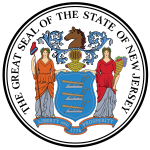| ||||||||||||||||||||
| Turnout | 38.5%[1] ( | |||||||||||||||||||
|---|---|---|---|---|---|---|---|---|---|---|---|---|---|---|---|---|---|---|---|---|
| ||||||||||||||||||||
Murphy: 40–50% 50–60% 60–70% 70–80% 80–90% >90% Guadagno: 40–50% 50–60% 60–70% 70–80% >90% Tie: 40–50% 50% No votes | ||||||||||||||||||||
| ||||||||||||||||||||
| Elections in New Jersey |
|---|
 |
The 2017 New Jersey gubernatorial election was held on November 7, 2017, to elect a new governor of New Jersey. Incumbent Republican governor Chris Christie was term-limited and could not seek a third consecutive term.[2]
Primary elections took place on June 6, 2017. Kim Guadagno, the incumbent lieutenant governor of New Jersey, won the Republican primary for governor and chose Woodcliff Lake Mayor Carlos Rendo as her running mate. Phil Murphy, a banker and former U.S. Ambassador to Germany, won the Democratic primary, and chose former State Assembly Speaker Sheila Oliver as his running mate. Seth Kaper-Dale ran as the Green Party candidate with Lisa Durden, while Pete Rohrman ran as the Libertarian Party candidate with Karrese Laguerre. Matt Riccardi ran as the Constitution Party candidate. There were two other independent candidates on the ballot.
Murphy led throughout the general election, with many analysts expecting a Democratic pickup. When polls closed on Election Day, Murphy was immediately declared the winner, based on exit polling alone. Murphy received 56.0% of the vote to Guadagno's 41.9%.[3] Murphy slightly outperformed Hillary Clinton's 2016 presidential run in the state. With the election of Sheila Oliver as lieutenant governor, she became the first woman of color elected to statewide office in New Jersey. 38.5% of registered voters cast ballots, marking the lowest turnout on record for any gubernatorial election in New Jersey.[4] Guadagno later left the Republican Party in July 2021.[5][6]
2017 was the first New Jersey gubernatorial election since 1989 in which the Democratic candidate won Somerset County, as well as the first since 2005 in which the Democratic candidate won Burlington County, Middlesex County, Atlantic County, or Gloucester County; the latter two counties have not voted Democratic for governor since. Murphy became the first New Jersey governor since Brendan Byrne in 1973 to win without any prior elected experience, and the first since Charles Edison in 1940 to win without having held any prior public office in the state. This is the first gubernatorial election since 1937 in which the Democratic nominee won without winning Salem County, and the first since 1981 that it voted for the losing candidate. This is the last time that the winner of the New Jersey gubernatorial election won a majority of New Jersey's counties.
- ^ "Total Number of Registered Voters, Ballots Cast, Ballots Rejected, Percentage of Ballots Cast and the Total Number of Election Districts in New Jersey" (PDF). Secretary of State of New Jersey. November 29, 2017. Archived from the original (PDF) on December 1, 2017. Retrieved November 29, 2017.
- ^ "Official List Candidates for Governor and Lieutenant Governor For November 2017 General Election" (PDF). New Jersey Department of State. Retrieved September 17, 2017.
- ^ "Phil Murphy beats Kim Guadagno to succeed Christie as N.J. governor". Nj.com. Retrieved November 8, 2017.
- ^ Symons, Michael. "NJ's governor's race cost $79 million but had lowest turnout ever". New Jersey 101.5. Retrieved October 24, 2021.
- ^ Wildstein, David (July 22, 2021). "Kim Guadagno, Christie's Lt. Governor, leaves Republican Party". New Jersey Globe. Retrieved March 3, 2024.
- ^ Cervenka, Susanne. "Kim Guadagno says goodbye to GOP. Ongoing rift with Shaun Golden cited". Asbury Park Press. Retrieved May 15, 2024.





